Photo Essay: The Historical Jubilees of His Highness the Aga Khan (1877-1957), the Imam of the Socio-Economic Revolution
Compiled by Malik Merchant, Editor
(On some browsers, please refresh page if only thumbnails appear)
I. 1885: Enthronement at Age Seven as 48th Ismaili Imam
November 2, 2015, marks the 138th birth anniversary of the 48th Ismaili Imam, His Highness the Aga Khan, Sir Sultan Mahomed Shah. Born in Karachi in 1877, he succeded his father, Imam Shah Aly Shah (a.s.), Aga Khan II, to the hereditary throne of the Ismaili Imamat in August 1885, when he was only seven. Soon after assuming the Imamat, he reminded his followers of his noble status as well as lineage from the Holy Prophet Muhammad (s.a.s.), and instilled in them courgage, confidence and hope at a time when they felt sad at the loss of their beloved 47th Imam. The seven year old Imam declared:
O Jamat do not consider me small. I am the descendant of the Prophet and my grandfather is Hazrat Amirul Mominin (Hazrat Ali) and my grandmother is Khatoon-e-Janat (the Lady of Paradise) Hazrat Bibi Fatima. I am the Light (Nur) of both Hazrat Ali and the Prophet (Muhammad). Though young in age I am exalted.

September 1, 1885: The 7-year-old Aga Khan III at his enthronement ceremony as 48th Imam of the Shia Ismaili Ismaili Muslims in Mumbai. He is surrounded by community elders. Photo: Keystone/Hulton Archive/Getty Images, Copyright.
The Imam continued:
We Imams change the physical bodies in this world but our Nur is eternal and originates from the very beginning. You should therefore take it as one Nur. The Light of God is ever present. The Throne of the Imamat of Mawlana Murtaza Ali continues and it will remain till the Day of Judgement. — excerpts from “Le Renovation du Shiisme Ismailien en Inde et au Pakistan” by Michele Boivien.
__________________
II. Imamat and the Imam of the Time
Each Imam presents to the world of his time that facet of the multi-faceted splendour the Ismailis call Imamat. All Ismaili philosophers have emphasized the principle of the Unity of Imamat under the superficial diversity exhibited by each Imam of the Time. It is in this sense that the Ismailis believe that Imam is the same irrespective of his own age or the time he lives in….The proverbial valour and exemplary statesmanship of Imam Mawla Murtaza Ali, the encyclopaedic erudition of Imam Ja’far as-Sadiq, the extraordinary intellectual brilliance of Imam al-Hakim bi Amrillah, the administrative ability of Imam Mustansir Billah (during the first half of his Khilafat), the political acumen of Imam Sultan Muhammad Shah (he defied geography and created history), the organizing genius of the present Imam, Shah Karim al-Husayni, are only some of the more spectacular characteristics exhibited by the Imam of the Time in accordance with the exigencies of the situations facing him….Excerpts from an article by the late Esmail Thawerbhoy, Ismaili lawyer and writer.
____________________
III. The Jubilees: An Affirmation of Love for the Imam of the Time
Say (O Muhammad): No reward do I ask (for my favours) except your love for my kith and kin – Holy Qur’an, Sura 42, Ayat 23
Mawlana Sultan Mahomed Shah’s Imamat lasted a total of 72 years – the longest in Ismaili history. Among the most eventful years of his Imamat were the years of the three Glorious Jubilees – Golden, Diamond and Platinum – which were marked to commemorate his 50, 60 and 70 years of Imamat respectively.
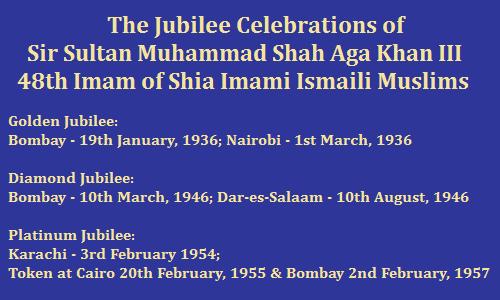
The dates and locations of the celebrations of the Golden, Diamond and Platinum Jubilees of His Highness the Aga Khan.
The Jubilees of the Ismaili Imam were often described in fantastic terms by the media around the world for their pomp and the precious metals that were used to weigh him. They were equated with golden jubilees of other potentates in India, who were weighed in gold, as was customary.
The Ismailis, however, saw these celebrations as a symbolic affirmation of the spiritual ties that linked them with their beloved Imam. The Imam had been responsible for their material and spiritual advancement, keeping them on the course of the straight path (Siratal Mustaqim).

While the first half of the 20th century resulted in significant development for the Ismaili community, the greatest impact resulted from the proceeds that Mawlana Sultan Mahomed Shah gave back to the community from the Jubilee ceremonies of weighing him in gold, diamond and platinum. Numerous institutions for social and economic development were established, in the Imam’s words, “for the relief of humanity.”

A portrait of His Highness the Aga Khan by Dorothy Wilding, bromide print, 1953. (C) National Portrait Gallery, London
Thus, the perception of Jubilees changed over time, even in the more popular media. What were seen as flamboyant celebrations are viewed today as celebrations that led to the transformation of the Ismaili community into a modern, dynamic and enterprising community under the leadership of both the 48th Imam, and his successor, the current Imam, Mawlana Shah Karim al-Husayni Aga Khan, who already has two Jubilees recorded under his fifty-five year reign, the Silver Jubilee in 1982 and the Golden Jubilee in 2007.
_________________________
IV. The Golden Jubilee – Fifty Years of Imamat
I accept with great pleasure the gold my dear spiritual children have offered me, and give them my loving and paternal spiritual blessings… I have decided to use the gold for the uplift of the spiritual children
In August, 1935 Imam Sultan Mahomed Shah completed fifty years of his spiritual leadership and the Ismailis decided to pay a memorable tribute to their Imam by weighing him against gold and making a present of it, as a mark of their love and gratitude, and as an acknowledgement of his leadership which had not only brought them worldly prosperity but spiritual strength as well.
GOLDEN JUBILEE, MUMBAI, 19TH JANUARY, 1936

Imam Sultan Mahomed Shah and the Begum (Andrée Carron, the late Prince Sadruddin Aga Khan’s mother) arrived promptly at 10.35 a.m. to receive one of the most spectacular ovations from a crowd of over 30,000 Ismailis. Every inch of space in the vast grounds was taken up. Those who could not get in lined the roads and streets nearby. Reaching the dais, Imam Sultan Mahomed Shah took his seat on the gadi (throne) embroidered in real gold with the coat of arms of his family. To his right sat Lady Aly Shah, the proud mother, and to his left sat the Begum.
Before the weighing ceremony, Mr. Gulamali Merchant, Vice-President of the All India Golden Jubilee Committee, requested the Imam’s permission as follows:
Most reverently and respectfully I request that Your Highness will allow yourself to be weighed in gold on this happy and auspicious occasion, and accept the gold so weighed as a humble token of our love, devotion and gratitude to Your Highness for all the unbounded bounty and benefits that Your Highness’ followers have derived during Your Highness’ Imamat for the last 50 years.

Imam Sultan Mahomed Shah rose from his “gadi” – moved towards the weighing scale and took his seat on rich soft cushions placed for him. Although the Imam was only 5ft 5in, he tipped the scales at 220lbs and the donations added up to $125,000 – a vast fortune in 1936. The ceremony of sitting on the scales with the gold made a great impression on the British public at the time. In the west, this was seen as some sort of fantastic ceremonial, and this was because India at the time was ceremonial. Replying to the address and weighing ceremony, the Imam said:
I accept with great pleasure the gold my dear spiritual children have offered me, and give them my loving and paternal spiritual blessings. I have decided to use the gold for the uplift of the spiritual children and appoint Mr. Gulamali G. Merchant to devise the best means of applying not only the income of this gold but the corpus also for intensive uplift work by way of all kinds of scholarships, relief by emigration from congested districts, infant welfare and other beneficial works.
________________
GOLDEN JUBILEE, NAIROBI, MARCH 1, 1936
The Golden Jubilee celebrations in Nairobi on 1st March 1936, were also as grand as those in Mumbai. East African Railways ran special trains called Aga Khan Specials, taking Ismaili travellers to Nairobi for the Jubilee. These trains were decorated with flags, played festive music and offered a special rate. Before and after the Jubilee, Mawlana Sultan Mahomed Shah visited many places in East Africa and gave guidance to his community for their progress.

His Highness the Aga Khan being weighed in gold during his Golden Jubilee celebrations held in Nairobi in 1936. From left to right behind the Imam are Manji Janmohamed Hasham Verjee, President of the Nairobi Provincial Council, Count (and later Diwan) Gulanhussein Mohamed Nasr Jindani, the Chairman of The Executive Council for Africa; Esmail Jivraj Pirani, a member of the Executive Council for Africa, who is seen holding the Address of Welcome which Count Jindani delivered. The Governor of Kenya is given the gold bars by the Mukhi and his Aid-de-camp is seen with hands to the back. Photo/Caption: Shaukat Noormohamed, Toronto/Mohammad Jindani, UK..
~~~
For the Nairobi ceremony, Mawlana Sultan Mahomed Shah wore a sherwani with golden colour turban. The Begum wore green and red sari. The Jubilee message from the All Africa Jamat was presented in a very beautifully carved ivory casket. Kenya’s Acting Governor placed the first gold bar on the scale and the whole jubilee ceremony was serene and beautiful. Once more the precious metal was presented to the Imam by his followers as a token of their love and affection and once more the Imam returned the gift, with his blessings, for the welfare and progress of the Ismaili community. He had weighed in with the gold value of $111,248 (22,773 Sterling pounds).
These two jubilee celebrations were a major step in laying the foundation of the community’s economic strength.

His Highness the Aga Khan showing his happiness during the ceremony marking his Golden Jubilee in Nairobi, Kenya on March 1, 1936. His Highness weighed against gold valued at $111,248 (22,773 Sterling pounds). Photo: Motani Collection, Ottawa.
~~~~~~
A GOLDEN JUBILEE PROJECT: THE JUBILEE INSURANCE COMPANY
In 1937, East Africa was in the grip of a world recession and the threat of world war was looming in Europe. Several businesses had collapsed and the confidence of the business community was at its lowest ebb, and many had lost their pioneering spirit. It was at this time that Sir Sultan Mahomed Shah, Aga Khan III, encouraged the East African Ismailis to start an insurance Company. All the insurance companies at that time were foreign based and it was a bold step indeed to incorporate a company locally. The Aga Khan had commented on the fact that the community was entirely reliant upon insurance companies controlled from Britain and India for its entire insurance needs, with the result that significant sums of money were being diverted from Ismaili hands instead of being funnelled into enterprises that would enhance community development.
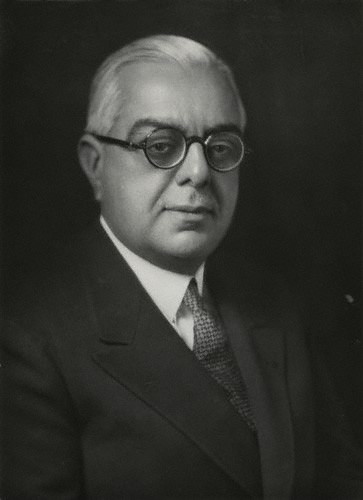
A portrait of His Highness the Aga Khan by Elliott & Fry, Vintage Print. (C) National Portrait Gallery, London
~~~
A three day meeting was then held at the Jamatkhana in the then Government Road (present day Moi Avenue in Nairobi) in which the Aga Khan listened patiently to the ideas that were being put forward. He interjected with suggestions from time to time and finally a decision was made to create an Ismaili insurance company following a unanimous vote. At once, the Aga Khan asked for volunteers willing to serve as directors of the fledging company, and seven of the delegates offered their services. The directors were drawn from all over East Africa, with six from Mombasa, four from Zanzibar and its neighbouring islands and one each from Nairobi, Masaka (Uganda), and Dar-es-Salaam.

His Highness the Aga Khan in full regalia. Photo: Jehangir Merchant Collection, Vancouver, Canada.
~~~
Within a few months Jubilee had issued over 1,200 life policies and, in 1938, appointed agents in several towns throughout East Africa. On 3rd February 1939, what proved to be a momentous event in the Company’s history occurred with the appointment of the late Sir Diwan Eboo Pirbhai, to the Jubilee Board. Years later, Sir Eboo was to recall the early days of Jubilee thus:
The late Aga Khan was determined that his Golden Jubilee be marked by the launch of something that would remain forever. After much discussion,the Jubilee Insurance Company was formed and when some leaders complained that they knew nothing about insurance, His Highness replied: ‘If you want to build a factory, you don’t do it yourself, you get experts to do it’.
_____________________________
V. The Diamond Jubilee – Sixty Years of Imamat
“AN INCOMPARABLE OCCASION”
The sixtieth anniversary of my inheriting my Imamat and ascending the “Gadi” fell in 1945. But in the troubled conditions at the end of the Second World War it was neither possible nor suitable to arrange any elaborate celebrations of my Diamond Jubilee. We decided to have two ceremonies: one, including the weighing against Diamonds, in Bombay in March 1946, and another five months later, in Dar-es-Salaam, using the same diamonds….Excerpt from Memoirs of Aga Khan
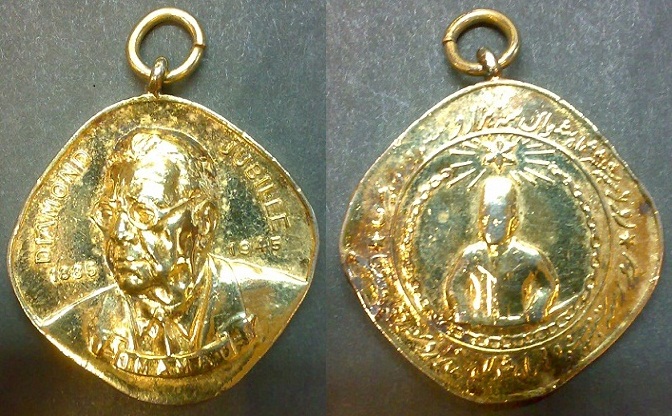
The obverse and reverse sides of a medal issued to commemorate the Diamond Jubilee of His Highness the Aga Khan. Photo: Nizar Noorali Collection, Pakistan.
Sixty years have passed to the enthronement of the Imamat, which is a unique occasion. It is an incomparable occasion in the world. No occasion ever occurred in the world history like it…..The Ismailia history has passed through several stages of development. My Diamond Jubilee marks such a stage in the present times. With it a phase of consolidation and co-operation has been achieved among my spiritual children in various countries, and now lies ahead a period of goodwill and expansion….His Highness the Aga Khan
DIAMOND JUBILEE, MUMBAI, MARCH 10, 1946
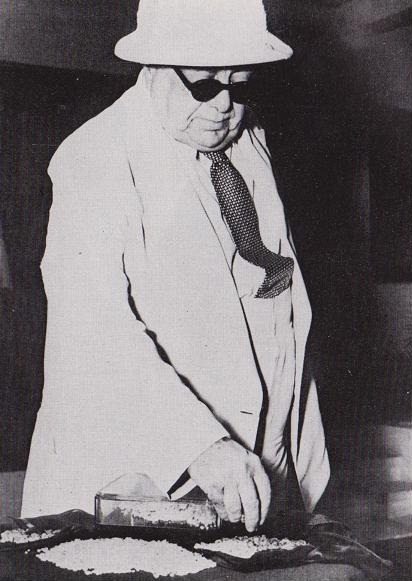
At his residence in Mumbai, His Highness the Aga Khan examines some of the diamonds before the day of the Diamond Jubilee Ceremony in the city’s Brabourne Stadium. Photo: Ilm magazine
~~~
When the time came [for the Diamond Jubilee], world conditions were only just beginning to improve…my followers gathered for a wonderful, and to me at least, quite an unforgettable occasion. There were Ismailis present from all over the Near and Middle East, from Central Asia and China; from Syria and Egypt; and from Burma and Malaya, as well as thousands of my Indian followers. Telegrams and letters of congratulation showered in on me from all over the Islamic world….I was proud and happy man to be thus reunited with those for whom across the years my affection and my responsibility have been so deep and so constant….Excerpt from The Memoirs of Aga Khan

Mawlana Sultan Mahomed Shah Aga Khan with the Begum Aga Khan (Mata Salamat) and Prince Sadruddin Aga Khan at a mulaqat with Mumbai’s Karimabad Jamat during his Diamond Jubilee visit.
~~~
At a quarter past five on the afternoon of Sunday, March 10, 1946, a deep hush fell upon the Brabourne Stadium in Mumbai. Here over 100,000 people, from various parts of the world had come to witness one of those magnificent ceremonies which arouse wonder and amazement in the minds of men. It was on this day, and at this hour, that His Highness the Aga Khan was to be weighed in diamonds to celebrate the sixtieth year of his Imamat. Seldom before can Mumbai, even in its pageantry and glory, have looked upon such pompous ceremonies, such splendour and colour.

~~~
Vast congregations of people lined the routes and filled the great stands surrounding the central platform and figure. The flags waved and the colours of His Highness – green and red – draped the buildings. Processions passed through the streets of Mumbai to the Stadium. At 5.15, His Highness the Aga Khan with his retinue preceded by Her Highness the Begum Om Habiba Mata Salamat, strode into the arena, mounted the platform and took his place.
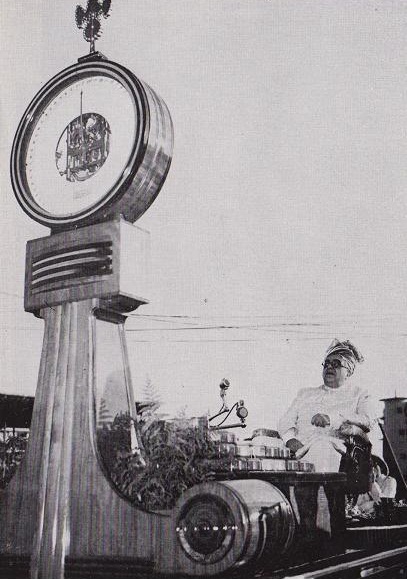
The Diamond Jubilee ceremony at Mumbai’s Brabourne Stadium. His Highness the Aga Khan looks at the scales as it nears the zero mark, indicating that he is evenly balanced in weight against the diamonds valued at 640,000 pounds (sterling). The diamonds are in palstic boxes on the scale.
~~~
One by one, the caskets of diamonds were raised on high and shown to the public, then placed on the scales. The scales tipped when 243 lbs. weight of diamonds were so placed. These diamonds were worth 640,000 British Pounds – a gift to His Highness from his many followers in India. His Highness received the gift and in his turn returned it, adding his blessing and his advice that the large sum of money should be used for the betterment of his followers.
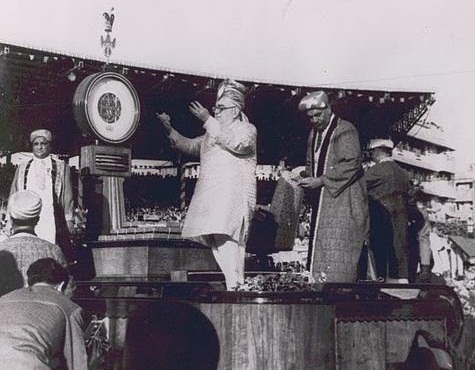
His Highness the Aga Khan shows his appreciation and blesses the crowd after the diamond weighing ceremony at Mumbai’s Brabourne Stadium on 10 March 1946 to mark his 60 years of Imamat. Photo: Karim Jassani Collection, Ottawa. Mr. Jassani’s late father, Itmadi Ebrahim Meherally Jassani, is seen at the right of the scale.
DIAMOND JUBILEE MESSAGES OF HIS HIGHNESS THE AGA KHAN IN MUMBAI
The Ismailia history has passed through several stages of development. My Diamond Jubilee marks such a stage in the present times. With it a phase of consolidation and co-operation has been achieved among my spiritual children in various countries, and now lies ahead a period of goodwill and expansion. With the Diamond Jubilee dawns a new era, full of hopes and opportunities for economics, educational, social and religious uplift of my beloved spiritual children all over the world. It is a time to go ahead and leave a mark on the world history like the glorious Ismailis of the past. Let the Diamond Jubilee message for my spiritual children be that of doing their best and devoting their best in the best cause of their beloved faith….His Highness the Aga Khan, Diamond Jubilee Souvenir Year Book
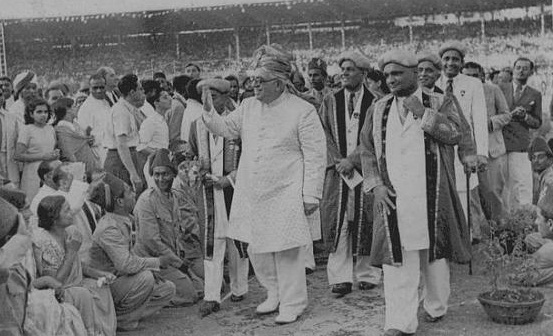
48th Imam of the Ismailis, His Highness the Aga Khan III, accompanied by smiling Ismaili leaders, walks by a cheerful and happy group of volunteers at the Diamond Jubilee celebrations held in Mumbai’s Brabourne Stadium. The diamonds that he was weighed against were worth 640,000 British pounds and the money was returned by the Imam for the community’s social uplifment programs. Photo Credit: Karim Jassani Collection, Ottawa. Mr. Jassani’s late father, Itmadi Ebrahim Meherally Jassani, is seen at the right, and walking immediately behind him with a stick is Vazir Kassamali Javeri. In the centre is Varas Daya Vellji, holding an envelope.
__________
DIAMOND JUBILEE, DAR-ES-SALAAM, AUGUST 10, 1946
The flash of diamonds – thousands of diamonds – in small hermetically sealed glass containers, tantalised the huge gathering seated around the high platform erected in the middle of grounds that had been converted into “Diamondabad” in the city of Dar-es-Salaam….The crowd watched spellbound as container after container put on the scale shook the hand and forced it upwards…From The Khojas A Vanished Community –

A close-up of the Diamond Jubilee scale that was used to weigh His Highness the Aga Khan against diamonds. The same scale was used for both the Mumbai and Dar-es-Salaam ceremonies. The scale today lies at Upanga Jamatkhana in Dar-es-Salaam. Photo: Al-Karim Pirani, Ottawa, Canada
The Diamond Jubilee celebrations in Dar-es-Salaam followed in August, 1946. Thousands of people came from all parts of the world, especially India, Europe and the Middle East. Hundreds made the journey by air, thousands by train, by car and by lorry, from all parts of Africa, many enduring hardships as they travelled from Belgian Congo and Uganda. Convoys of cars came from South Africa. The specially chartered mailboat, S.S. Vasna, flying the Ismaili flag, brought many thousands of Ismailis to Dar-es-Salaam.
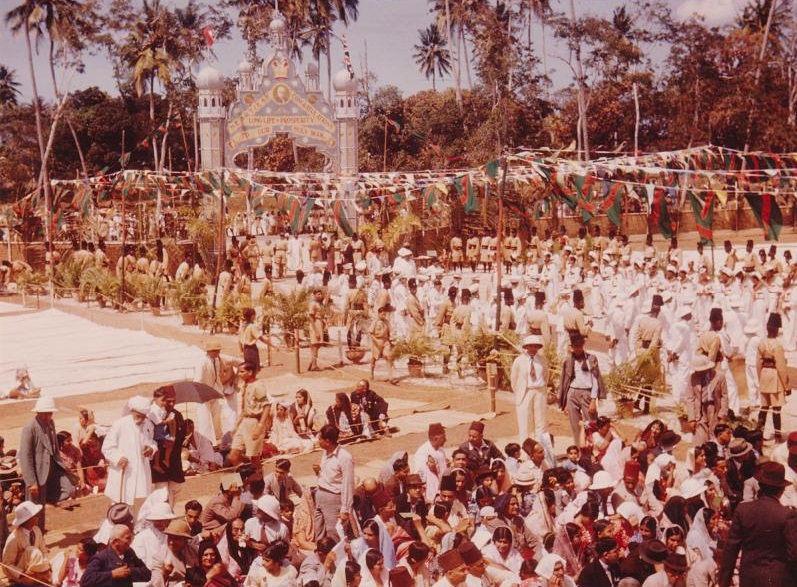
Fezzed Tanganyika Police Keep Order and Guard a fabulous Diamond treasure at the Jubilee celebration of His Highness the Aga Khan in Dar-es-Salaam on August 10, 1946. National Geographic Magazine, March 1947.
~~~
The celebrations lasted ten days, opening with a ceremony in which Her Highness the Begum, accompanied by Lady Battershill, cut the tape at the official opening of the Jubilee Exhibition Park. Here there were pavilions showing fine needlework and other forms of local craftsmanship, including paintings, woodwork and toy-making. Other pavilions were on health, hygiene, child welfare and domestic science, and others catered to Scout and Girl Guide displays.The lighter side of the Exhibition took on the features of a grand country fair. Merry-go-rounds and miniature railways delighted the young and kept the old entertained. A day was also dedicated to a large procession, which included decorated floats, and a portrayal of the history and activities of the Ismailis.
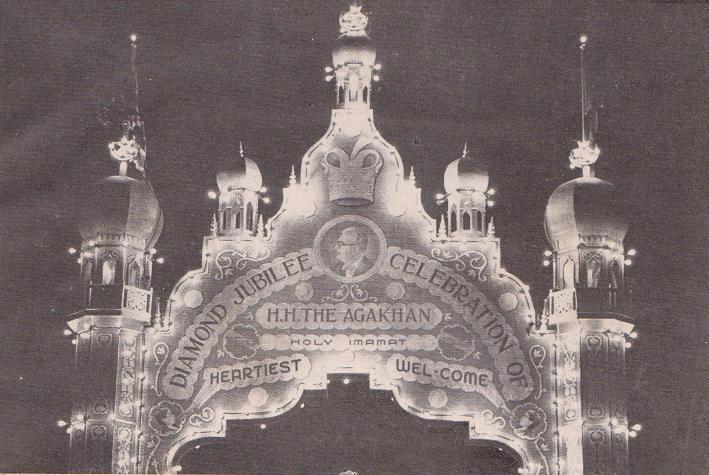
A close up of the Diamond Jubilee arch, shown in the previous photo.
~~~
However the highlight of the celebrations had to be the morning of August 10, 1946 when 70,000 pairs of eyes, mesmerised by the hand on the large round dial of an enormous weighing scale, watched as it inched its way up and up. The flash of diamonds – thousands of diamonds – in small hermetically sealed glass containers, tantalised the huge gathering seated around the high platform erected in the middle of grounds that had been converted into Diamondabad in the city of Dar-es-Salaam. The first boxes of diamonds were placed on the scales by those who had contributed the highest amounts…Following this there were presentations by school children, bearing banners from all the African territories.

His Highness the Aga Khan speaking at the Diamond Jubilee Celebrations in Dar-es-Salaam. From Madagascar to Central Asia, Ismaili pilgrims converged on the city for the weighing ceremony on August 10, 1946 in Dar-es-Salaam. Five months earlier many saw a similar weighing in Bombay. Both ceremonies raised over 640,000 British pounds each in the 48th Ismaili Imam’s weight against diamonds.
~~~
The crowd watched spellbound as container after container put on the scale shook the hand and forced it upwards. Some craned their necks, others squinted, and all focused on the dial, willing more and more diamonds onto the scale as the hand moved clockwise, very slowly towards its target – the weight of the regal person seated at the end of the platform, serenely awaiting the outcome. The Imam’s weight in diamonds would represent a fortune and the weighing-in was a sumptuous display of wealth, power and charity in one spectacular event.
Ismailis from all parts of the world sat tense with suppressed excitement. Finally the weight on the scale matched the weight of the Imam and a tremendous cheer broke from their lips in praise of their leader on the platform, His Highness, Sultan Mahomed Shah Aga Khan. He had succeeded to the Imamate at the age of eight in 1885 and they were celebrating his sixtieth anniversary as Imam.
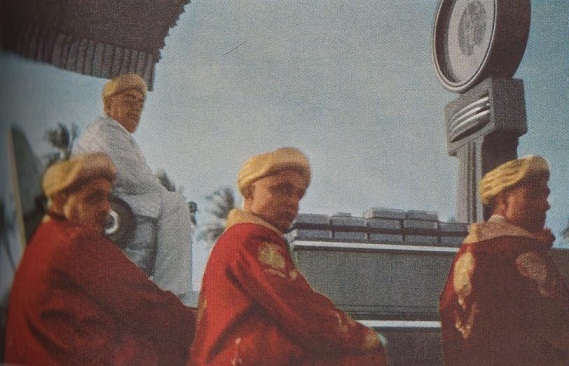
Bulletproof caskets of transparent plastic rest on the scale. These contain industrial diamonds on loan from London for the weighing. The setting was Dar es Salaam, Tanganyika, East Africa, a stronghold of the Ismailis. Scarlet-robed members of the Aga Khan Legion surround the Imam. Photo: National Geographic, March 1947
~~~
The Aga Khan, moved by this presentation, explained how the gift would be used, as follows:
As everyone is well aware, the value of these diamonds has been unconditionally presented to me on this occasion. I do not wish to take this money for myself but to use it for any object that I think is best for my spiritual children. After long reflection, I have come to the conclusion that the very best use that I can make of it is that after expenses of these celebrations, in the wider sense of the word, have been paid for, then the whole of the residue must be given as an absolute gift to the Diamond Jubilee Investment Trust.
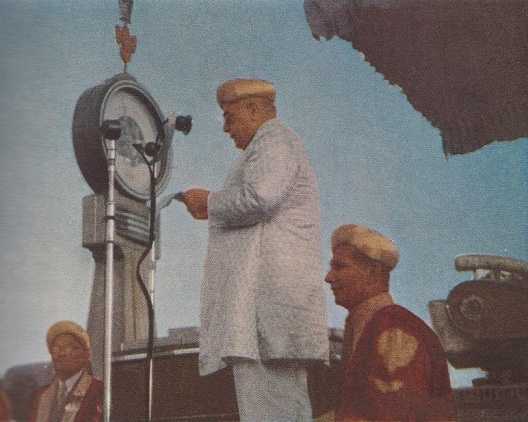
His Highness the Aga Khan speaks into a “Mike” at the Diamond Jubilee celebrations in Dar-es-Salaam. His weight in diamonds was the equivalent of over 640,000 Britsh pounds Photo: David Carnegie for the National Geographic, March 1947.
~~~
He told them that the Diamond Jubilee Investment Trust had been created to build up “a totally new financial outlook among the Ismailis. Co-operative Societies, Corporations, and, I hope and believe very soon, Building Societies, too, will draw from the Investment Trust sums equal to their capital but at a level of three per cent. And they are not allowed to charge more than six per cent under any conditions from their borrowers.” With this internal banking system, His Highness was setting up the means to ensure financial security for all his people.
Stirred by his wisdom and his concern for them, his followers felt reaffirmed in their faith and in their leader. It was an occasion each individual would cherish forever.
____________________
DIAMOND JUBILEE MESSAGE OF HIS HIGHNESS THE AGA KHAN IN DAR-ES-SALAAM
White, black and brown are complementary members of a common body politic
Now one word, if I may be allowed to say it, of general advice to inhabitants here, whatever their race, colour or creed.
I have had some experience of the causes of strife and I was a very active member of the League of Nations and of the Disarmament Conference for some seven years. Why did it fail? Ultimately because of hate. And yet why did people hate each other? Fear. Where there is fear there is no love, but hate easily enters through the windows even if the door is shut. I appeal to all of you, Africans, Europeans and Indians — do not fear each other. Work together. The country is big enough….To-day, strife here on racial lines is imaginary. The onlooker sees most of the game, and I have been here an onlooker. There is no getting away from it — if you will throw fear out of your minds and you will soon realise that white, black and brown are complementary members of a common body politic…..His Highness the Aga Khan, Exhibition Theatre, Dar-es-Salaam, August 10, 1946, at the Exhibition Theatre
_______________________
DIAMOND JUBILEE PROJECTS AND REFLECTIONS
-
What is now known as the Diamond Trust Bank of Kenya was incorporated in 1946 as the Diamond Jubilee Investment Trust (DJIT) to commemorate the Diamond Jubilee of the ascension to the Imamat by the late Aga Khan III. DJIT’s shares were subscribed by the Ismaili Community as well as His Highness the Aga Khan.
-
In 1947, following India’s Independence from the British, His Highness established the Diamond Jubilee High School for Boys. Over the years, the school has established itself as an institution offering quality education to children of varied backgrounds and cultures.
-
The Diamond Jubilee High School in Hyderabad, a co-educational English medium school, currently educates 1040 students from pre-primary through grade 10. The school was established in 1949 by the Youngmen Ismailia Education Board.
-
Those who are familiar with the difficult terrain and relatively scarce resources in Hunza would be pleasantly surprised to know that the literacy rate in Hunza is around 77 per cent. The single-most important factor that transformed the educational scene in Hunza was the contribution of the 48th Ismaili Imam who convinced the then Mirs of Hunza state to place greater emphasis on education. It was in 1946 that some 16 schools were established. They were called the Diamond Jubilee schools and they set the right momentum for bringing changes to education in Hunza. Diamond Jubilee Schools for girls were also set up throughout the remote Northern Areas of Pakistan. In addition, scholarship programmes established at the time of the Golden Jubilee to give assistance to needy students were progressively expanded.~~~
The single-most important factor that transformed the educational scene in Hunza was the contribution of Aga Khan III, Sir Sultan Muhammad Shah. It was in 1946 that some 16 schools were established. They were called the Diamond Jubilee schools and they set the right momentum for bringing changes to education in Hunza….Dawn Newspaper, Pakistan
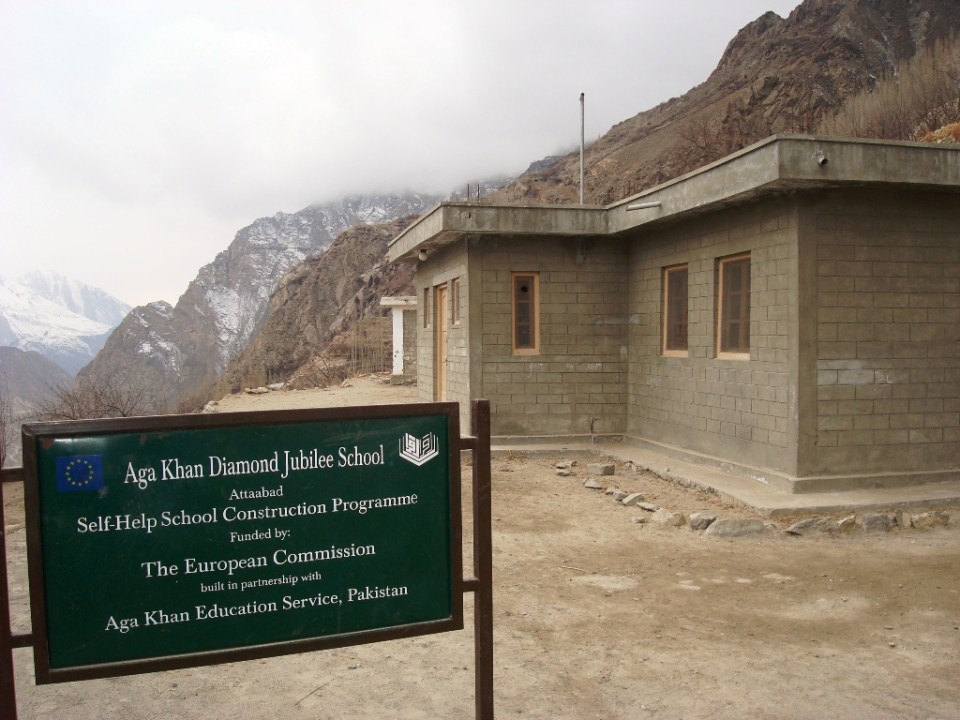
A modern Diamond Jubilee School in Attabad, Hunza. Photo: Ismailimail.
~~~
My Silver Jubilee is a celebration of years which have passed, but it is fitting that it should be commemorated by laying foundations for the future….it was here that my grandfather, Sir Sultan Mohammed Shah Aga Khan, initiated our education network for the Northern Areas. He did this with faith in the future. It therefore gives me great pleasure that today we are inaugurating a completely new development in the system he originated…His Highness Prince Karim Aga Khan, speaking at the Aga Khan Academy Foundation Ceremony, Karimabad, Hunza, May 13, 1983
___________________
VI. The Platinum Jubilee – Seventy Years of Imamat
…Work if carried out intensively, is service to God and Fatherland. Make your daily labour, labour of love howsoever difficult and hard it may be…If every Ismaili living in Pakistan remembers and interprets his citizenship, howsoever humble his contributions may be, with the spirit of courage and devotion, then indeed I am happy to think that after many years of surgical operations and illness, I am still alive to give you this fatherly advice….though you must firmly stick to the tenets of your Faith, yet you should not forget what I have always considered the most beautiful of all Muslim prayers namely, that Allah Almighty in His infinite mercy may forgive the sins of all Muslims….His Highness the Aga Khan
PLATINUM JUBILEE, KARACHI, FEBRUARY 3, 1954
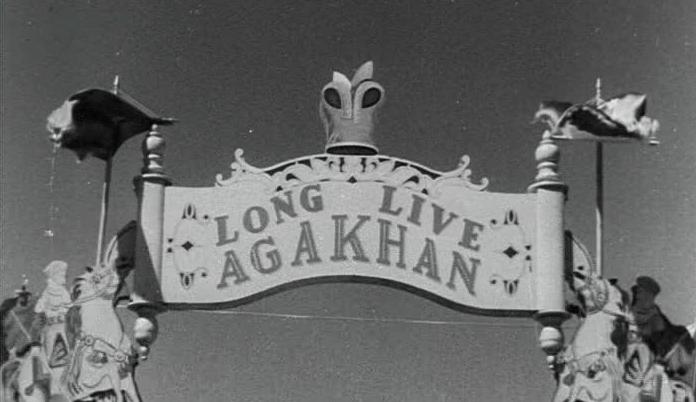
A banner at the Karachi Aga Khan Gymkhana wishing His Highness the Aga Khan a long life. The 48th Ismaili Imam reigned for 72 years, the longest Imamat in the history of the community.
To mark the completion of His Highness the Aga Khan’s seventy years of Imamat, the Ismailis decided to weigh their 48th Imam, who had guided them through seventy years of benevolent rule, in platinum. The preparations were set afoot to surpass all the celebrations of the previous two Jubilees but Imam Sultan Mahomed Shah gave explicit orders not to over spend on illuminations and festivities.

His Highness the Aga Khan blessing his Ismaili followers during the historical Platinum Jubilee celebration in Karachi marking his 70th Imamat aniversary
The Platinum Jubilee was celebrated at the Aga Khan Gymkhana in Karachi, the birthplace of Imam Sultan Mahomed Shah, on 3rd February, 1954 in the presence of 50,000 Ismailis. The Imam appeared in a ceremonial high-walled black cap, a white tunic and a brown, embroidered robe. Mata Salamat Om Habibah and Pakistan’s Prime Minister Mohammad Ali were also present for the ceremony.

His Highness the Aga Khan acknowledges the affection of his followers who had gathered in their thousands to mark his Platinum Jubilee celebration at the Aga Khan Gymkhana in Karachi. He is seen about to deliver his address.
Being the costliest metal, it was determined that every one once of platinum would represent 14 pounds in weight. The scales were adjusted accordingly and Wazir Ibrahim Manji, the President of the Platinum Jubilee Association, placed a total of 15 ounces of platinum to match the Imam’s weight of 215 pounds. The weighing ceremony itself was brief, lasting ten minutes. Once again, as had been the case with the Golden and Diamond Jubilees to celebrate 50 and 60 years of Imamat respectively, the sum gifted to the Imam was returned for the community’s Finance and Investment Corporations.
_____________
PLATINUM JUBILEE MESSAGES OF HIS HIGHNESS THE AGA KHAN IN KARACHI
“Make your daily labour, labour of love”
I realise fully that the overwhelming majority of the population have to look after their means of livelihood and the up-bringing of your children, but work if carried out intensively, is service to God and Fatherland. Make your daily labour, labour of love howsoever difficult and hard it may be. Do remember that in a democracy, voting and the rights of citizenship should be used with care and attention with serious thought howsoever humble with the full realisation to the best of your ability that not personal, parochial or provincial interests are to be served but the greater good and the welfare of the population as a whole and the security of the state as such.

A historical day for the Ismailis as they celebrate the completion of 70 years of the rule of His Highness the Aga Khan by weighing him in Platinum in Karachi. The ceremonies that followed later in India and Africa were token ceremonies, due to the Imam’s ill-health.
“Misfortunes can be overcome”
If the people of a nation are united and self-sacrificing, any amount of difficulties and overwhelming misfortunes can be overcome. We have seen how Turkey has come out stronger than ever after a hundred years of misfortunes and disasters. There are two other cases which should be an example and should not discourage anyone in the face of difficulties. Germany and Japan after the greatest defeats known to history have by hard work and devotion raised themselves to be honoured, respected and powerful members of the comity of nations.
A Message to the Ismailis
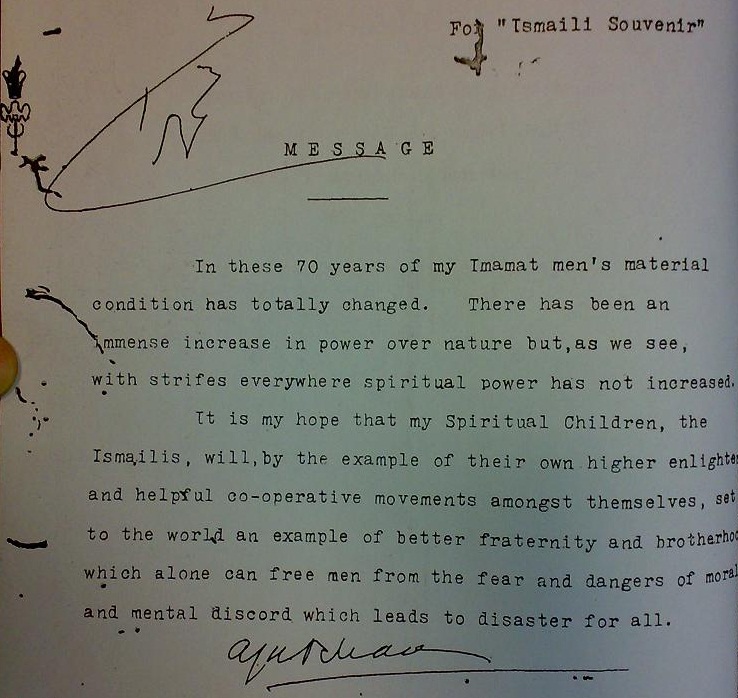
A message by His Highness the Aga Khan published in the Platinum Jubilee Souvenir Issue asked his followers to set examples of fratenity and goodwill. See transcript below. Image: Nizar Noorali Collection, Pakistan
In these 70 years of my Imamat men’s material condition has totally changed. There has been an immense increase in power over nature but, as we see, with strifes everywhere spiritual power has not increased. It is my hope that my spiritual children, the Ismailis, will, by example of their own higher enlightenment and helpful co-operative movement amongst themselves, set to the world an example of better fraternity and brotherhood which alone can free men from the fear and dangers of moral and mental discord which leads to disaster for all….His Highness the Aga Khan
_____________________________
PLATINUM JUBILEE AFRICA, TOKEN CEREMONY, CAIRO, FEBRUARY 20, 1955
…..My seventy years Imamat is unique in the history of the forty eight Ismaili Imams by its long duration, but also it began in another world, the world of horse carriages and candle lights, and today we are in the world of nuclear power, physics, jet air-travel and serious discussion amongst the most learned as to how and when we can visit the stars and the moon.
Again due to the Ismaili Imam’s ill-health – he was 78 – the ceremony in Africa were restricted to a token ceremony in Cairo on 20th February, 1955. A description of the ceremony is described following the photo below. Earlier, on May 28th 1954, Mawlana Sultan Mahomed Shah had sent a special Platinum Jubilee message from Paris to the Africa Jamat:
As you all know it is my greatest desire that by 1960 each family should be owner of their own house, flat or shop-residence and for this purpose you must continue to develop and create more and more co-operative societies and corporations. The middle and upper class should join with the poor class to buy their shares and every effort should be made towards this end.
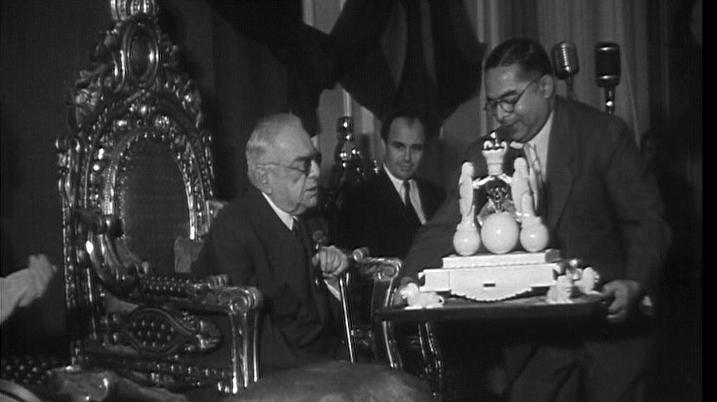
In Cairo’s token clelebation of the Platinum Jubilee, His Highness the Aga Khan being presented with an ivory gift set containing 48 platinum pieces which included the names of his 47 predecessors inscribed on them.
The Cairo Ceremony: A Newspaper Report
The Cleopatra Lounge of the Semiramis Hotel yesterday afternoon witnessed an impressive ceremony when the Aga Khan, spiritual leader of the Ismaili sect, was symbolically ‘weighed’ in the presence of a large number of his followers.
At 4 p.m. the Aga Khan, dressed in a dark grey suit and carrying a walking stick, entered the Lounge amidst the applause of the Ismaili representatives. He took his seat on a special rostrum, with the Begum on his right and his son, Prince Aly Khan, on his left.
The ceremony opened with the recital by Count Hassa Hassi [sic] Lakha of Uganda of the opening chapter of the Koran (Al Fatiha). The Aga Khan, after thanking those present for coming to Egypt to attend the ceremony, expressed his gratitude to the Government of Egypt for its hospitality and announced that he was donating L.E. 1,000 for the poor of Cairo.
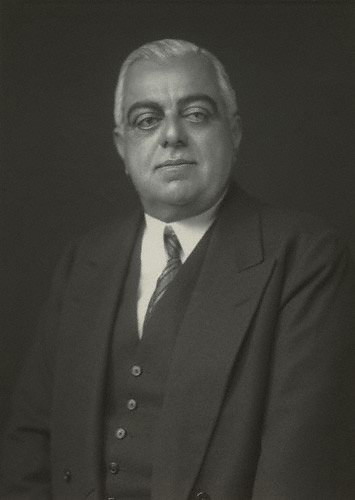
A portrait of His Higfhness the Aga Khan by Walter Stoneman, 1930 photograph, bromide print. (C) National Portrait Gallery, London
The Aga Khan was then presented with ivory scales and 48 pieces of platinum with the names of his 47 predecessors inscribed on them. On top of the scales were three small platinum balls bearing the inscriptions “Silver Jubilee,” [sic] “Golden Jubilee”, and “Platinum Jubilee.” Members of the Ismaili sect in turn kissed the Aga Khan’s hand and presented him with a platinum medals with his effigy on one side and the date of the ceremony on the other side. On behalf of his father, Prince Aly Khan made a speech in which he described the projects that had been carried out with the help of the money collected during the past two weighing ceremonies…..Excerpts of a report from “The Egyptian Gazette”
~~~~~~~~~~~~
The Platinum Jubilee Messages of His Highness the Aga Khan in Cairo
“There are two worlds — the world of material intelligence and the world of spiritual enlightenment”
On this unique occasion when you make this wonderful offering of platinum and its equivalent as an unconditional gift, I must immediately tell you that I give it to the Diamond Jubilee Investment Trust as further addition to its capital. You have referred to my seventy years Imamat which, indeed, is unique in the history of the forty eight Ismaili Imams by its long duration, but also it began in another world, the world of horse carriages and candle lights, and today we are in the world of nuclear power, physics, jet air-travel and serious discussion amongst the most learned as to how and when we can visit the stars and the moon.

His Highness the Aga Khan with Begum Om Habiba Mata Salamat and Prince Aly Khan (extreme right) at the Platinum Jubilee ceremony in Cairo. The Platinum coins are placed on the cushion. Photo: Motani Collection, Ottawa
….As I have explained in my Memoirs for the whole world to understand there are two worlds — the world of material intelligence and the world of spiritual enlightenment. The world of spiritual enlightenment is fundamentally different from the world of material intellectualism and it is the pride of the Ismailis that we firmly believe that the world of spiritual enlightenment has come as a truth from the inception of Islam to this day with the Imamat and carries with it as one of its necessary consequences love, tenderness, kindliness and gentleness towards firsts our brother and sister Muslims of all sects and, secondly, to those who live in righteousness conscience and justice towards their fellow men. These religious principles of Ismailism are well known to you for you have heard them from me and through your fathers and grandfathers and from my father and grandfather until I fear that by long familiarity with these teachings some of you forget the necessity of re-examination of your heart and religious experience.
…As I started by telling you, there is also the world of matter and intellect which go side by side with reason and deductive and inductive powers. I have never, as you say in your own address, neglected to encourage schools and universities, and by welfare societies for the health of children, maternity, and more and more up to date needs that you may have, as far as it is possible in the areas in which you live, to get both mental and physical training that will make you capable of meeting the more and more difficult conditions of life and competition….
REFLECTION ON A PLATINUM JUBILEE PROJECT – THE AGA KHAN HOSPITAL IN NAIROBI
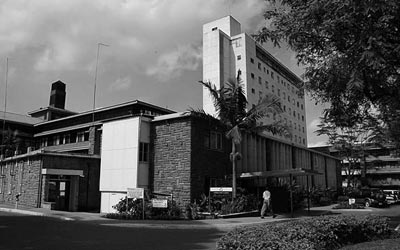
The Aga Khan Platinum Jubilee Hospital was built with funds raised by the Ismaili community, together with a contribution from the Kenya Government, to commemorate the 70th anniversary of the installation of His Highness Sir Sultan Mohammed Shah as the Imam of the Shia Imami Ismaili community. Photo: Agakhanhospitals.org
…As I started working in the [Platinum Jubilee Hospital] hospital and getting to know it better it also became obvious to me that it was ahead of its time. Strangely enough its origins were both archaic and radical. The money had come from members of the Ismaili community in East Africa who had weighed their late Imam in platinum to celebrate seventy years of his spiritual leadership. The community had previously used gold and diamonds to appropriately celebrate the length of time he had acted as sheppard of the flock. He had now been weighed in the most precious metal and the full official name of the hospital was therefore the Aga Khan Platinum Jubilee Hospital. The revolutionary part was the Aga Khan’s decision on how best to utilize this philanthropic gesture on the part of his community. In his wisdom he decided to build a modern hospital in Nairobi which was open to all races.
Unfortunately he died before the hospital was built and it fell upon his chosen successor and grandson, Karim Aga Khan, to open the hospital in 1958. This was indeed a great step, because until then, hospitals in Nairobi and other big towns catered for the needs of one ethnic community only. Into this compartmentalized health care, the entry of the well built, well equipped and well staffed Aga Khan Hospital with its multi-racial concept was a progressive move….Excerpts from “Nothing but the Truth” by Yusuf Kodwavwala Dawood
Note: The Hospital is now part of the Aga Khan Development Network and is known as the Aga Khan University Hospital, Nairobi.
PLATINUM JUBILEE INDIA, TOKEN CEREMONY, 1957
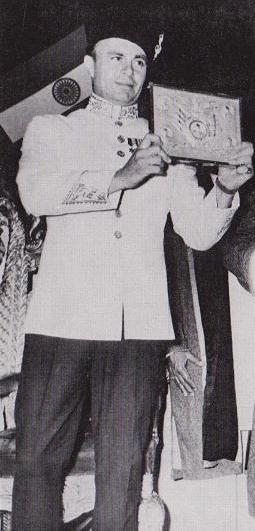
Prince Aly Khan on February 2, 1957 displays the Platinum Plaque which he received on behalf of his father,His Highness the Aga Khan, on the occasion of the Platinum Jubilee celebrations in Mumbai
Because of the Imam’s ill-health, the Platinum Jubilee ceremonies in India were officiated by Prince Aly Khan, and these were again restricted to token presentations. The ceremony was held in Mumbai on February 2, 1957 followed by ceremonies at eleven other centres from February 20 to 26.
___________________
VII. July 11, 1957: Succession
….The Ismailis pay homage to the Imam and that is when you are recognised by the world at large as the Imam. Officially as soon as one Imam passes away, his successor takes on from the very minute that the Imam has passed away….Current 49th Imam, His Highness Prince Karim Aga Khan

The thoughtful study of the late Aga Khan, 48th Imam of Shia Imami Ismailis, shown above was done in clay by his wife, the Begum Aga Khan, Om Habiba. Image by © Bettmann/CORBIS
Two years after the token Platinum Jubilee ceremonies in India, at forty minutes past midday on 11th July, 1957, the beloved 48th Imam of the Ismailis passsed away peacefully at his villa in Versoix, Switzerland, at the age of eighty leaving behind him a memorable history of his glorious and eventful life. An Ismaili author has summarized the Imam’s accomplishments as follows:
The measure of the Imam’s achievement can be gauged from the phenomenal progress of the Ismaili Community during the Imam’s regime. The community’s proud position in modern civilization during the course of only about half a century, is a saga of success with probably no parallel in history…the Imam was the architect of this modern miracle…The resurgence of the Ismaili Community, literally from rags to riches, is a fitting monument to the Imam’s indefatigable efforts…..Esmail Thawerbhoy
That the late Imam was also “a great force working for understanding and harmony between east and west”, was noted by The Times of London, and is clearly expressed in the following messages of universal appeal that he conveyed:
All men, rich and poor, must aid one another materially and personally. This fraternity is absolute, and it comprises men of all colours and all races: black, white, yellow, tawny; all are the sons of Adam in the flesh and all carry in them spark of the Divine Light. Everyone should strive his best to see that this spark be not extinguished but rather developed to that full Companionship-on-High.
His Highness the Aga Khan’s death was mourned by people of all communities around the world. For his followers the loss of their long reigning Imam once again became an occasion to reflect about their traditional and historical understanding and belief about the Institution that he had led – the Imamat. During this mourning and trying period the famous tradition (Hadith) of the Prophet Muhammad:
I am leaving behind me two things: the Book and my Progeny. If you hold fast to them, you will never go astray,
and the Quranic verses (3:33-34):
Verily, God did choose Adam and Noah, the progeny of Abraham, and the progeny of Imran above all the worlds, descendants, one from the other: And God heareth and knoweth all things.
became comforting factors as Ismailis globally awaited the announcement of who had been designated to continue the hereditary Imamat. The will of their beloved Imam was then read in front of the Imam’s family at Villa Barakat proclaiming the successor. It said:
Ever since the time of my first ancestor Ali, the first Imam, that is to say over a period of thirteen hundred years it has always been the tradition of our family that each Imam chooses his successor at his absolute and unfettered discretion from amongst any of his descendants whether they be sons or remoter male issue.
In view of the fundamentally altered conditions in the world in very recent years due to the great changes which have taken place including the discoveries of atomic science I am convinced that it is in the best interests of the Shia Moslem Ismailian Community that I should be succeeded by a young man who has been brought up and developed during recent years and in the midst of the new age and who brings a new outlook on life to his office as Imam.
I appoint my grandson Karim, the son of my son Aly Salomone Khan, to succeed to the title of Aga Khan and to be the Imam and Pir of all my Shia Ismailian followers.

A rare portrait of the family of His Highness the Aga Khan from the 1950’s. His Highness is seated with his grand-daughter Princess Yasmin Aga Khan next to him. Standing (l to r) are Prince Amyn Aga Aga Khan, the late Prince Sadruddin Aga Khan and his older brother, the late Prince Aly Khan holding his daughter Prince Yasmin Aga Khan, and Prince Karim Aga Khan, who was designated to succeed as the 49th Imam. Photo: Zul Khoja Collection, Ottawa.
Through the special designation (or the Nass) of the late Imam, Shah Karim al-Husayni became the 49th hereditary Imam of the Nizari Ismailis at the age of twenty. Shortly after, the newly enthroned Imam met Ismaili leaders and representatives from around the world, and made the following pledge:
My grandfather dedicated his life to the Imamat and Islam, both of which came first, and above all other considerations. While I was prepared that one day I might be designated the Aga Khan I did not expect it so soon. I follow a great man in a great responsibility and he could have given me no more appreciated honour than to bequeath me this spiritual leadership. My life, as his, will be dedicated to the service of my followers.
The passing away of Imam Sultan Mahomed Shah who had been with the Jamat for 72 years was a cause of great sorrow and sadness for Ismailis all over the world, but the loving care and guidance of Noor-e-Ilahi continued in Noor Mawlana Shah Karim al-Husayni, who said in an interview before his public installation ceremony in Dar-es-Salaam:
….The Ismailis pay homage to the Imam and that is when you are recognised by the world at large as the Imam. Officially as soon as one Imam passes away, his successor takes on from the very minute that the Imam has passed away

The newly enthroned 49th Imam, Shah Karim al-Husayni, surrounded by Ismaili leaders and their spouses at Villa Barakat on July 12, 1957:
The concept of Imamat as articulated by the 48th Imam, at the beginning of this piece, was also eloquently put forward by his grandson Mawlana Shah Karim, the present Imam, when he was asked by the London Sunday Times, “Are you, for all believing Ismailis, a symbol of their Faith?” His Highness the Aga Khan answered:
Since my grand-father, the last Aga Khan, died, I have been the bearer of the Noor, a word which means “The Light”. The Noor has been handed down in direct descent from the Prophet. But my work and responsibilities overflow into the practical side of life”…..His Highness Prince Karim Aga Khan, Sunday Times, UK, December 12, 1965.
Date posted: Monday, October 29, 2012
Last updated: Sunday, November 1, 2015.
______________
The above is a revised and condensed version from a special three part series on His Highness the Aga Khan’s Jubilees which appeared in November 2009 at this blog’s literary website, www.simerg.com.The material was compiled by the publisher and editor of the two websites from numerous sources listed at Simerg.
Profile of Malik Merchant at Contributors.
We welcome feedback/letters from our readers.
Please use the LEAVE A REPLY box which appears below. Your feedback may be edited for length and brevity, and is subject to moderation. We are unable to acknowledge unpublished letters.
Very well Written, well organized and well illustrated article. I started researching about information on Our Imam’s Jubilee celebrations for REC Open House project for Principal REC in Sugar Land, TX. We have our 2nd REC Open House “The Celebration of Imam’s Jubilees” theme on February 17th, 2017. I have got all the information I needed from this web page. Thank you for sharing this valuable information.
Great work and research done on the subject and made chronologically interesting for the readers!!!
What a long journey through Abdul Malik Merchant’s well researched Weblog of http://www.simerg.com! Bless him. I am refreshing my memory of going through this experience once again. Thank you Editor!
Reblogged this on Zarina's Weblog and commented:
What a long journey through Abdul Malik Merchant’s well researched Weblog of http://www.simerg.com! Bless him.
Pingback: Reflection: 138 Birth Anniversary of the 48th Ismaili Imam – His Highness Aga Sir Sultan Muhammad Shah, Aga Khan III | Ismailimail
A very well written article. I think every parent should make their young kids read this article so that they come to know about the glorious Jubilees of our beloved 48th Imam. Thanks Malik bhai for taking time and effort to put such a wonderful article along with gorgeous pictures.
Mubarakbad for such a wonderful work.
Very wonderful to see.
Indeed very lucky you guys are… Insha’Allah, we will all celebrate Imam’s Diamond Jubilee with great zest and vigor… Ameen!!!
Yesterday the 11th July 2017 was Hazar Imam’s Diamond Jubilee and by the grace of Mowla I was present at Excell London where the Ismailis of United Kingdom watched Mowlana Hazar Imam’s Diamond Jubilee.
Like many of my age, I am also very fortunate to have watched Imam Sultan Mohammad Shah’s Diamond Jubilee Bombay, Platinum Jubilee Karachi, Hazar Imam’s Takhtnashini’s of Daresalaam, Kampala, Nairobi, Karachi and Hazar Imam’s Silver Jubilee Karachi, Golden jubilee London and pray to Hazar Imam to keep me alive to watch the Diamond Jubilee also.
A nice history of the Jubilees of His Highness the Aga Khan.
I Like this page a lot and I thank you for this presentation of our history.
There is a lot of research done by the Editor. I do not care about price of gold then and ‘inaccuracies’ as a certain commentator has pointed out. I am glad not to boast about my Degrees or Educational achievements, least of all in Economics! Well, some people are above any criticism but love to do that of others!
Thanks for the great website and so many pictures and good history. One suggestion, please, if you don’t mind. With the black background, it is difficult to read. Is it possible to make this website with a white background??
I was 10 years old in 1954 Platinum Jubilee in Karachi and remember each and every detail of ceremony. Great time and great memories..—Aftab Cumber-Coral Springs, Florida.
Nice valuabble information. Keep it up and thanks a lot.
Interesting from the spiritual angle. From the material angle the data tell us lots about the well-being of the jamat. At the golden jubilee in Bombay the Imam weighed 220 lbs. The gold cost $111,278. The editor says that’s “a vast amount for that time.” Was it? First a fact-check: The price of gold in 1936 was $34.87 per ounce, so the value of gold entered is correct, +/-. How much was that money in today’s dollars? If we take the US GDP deflator then it was 13.39 times as much = $1.5 million. Today for the jamat to subscribe $1.5 million is nothing – the jamat is immeasurably rich these days. In 03 they subscribed $30 million to the AK University within a month. Was it a lot for the jamat in 1936 – India first and then Nairobi? Just 10 or so people came up with that amount.
Let’s look at how much it would cost to do that kind of golden jubilee. At today’s gold price ($1707 per oz), weighing the 48th Imam against gold would cost $6.23 million dollars. Is that a lot?! Compared to what, right? I’d stick my neck out that just 5 top Ismailis in Vancouver alone would come up with that amount at the drop of a pagri. Instead of a golden jubilee per se MHI guided us to do nazranas.
BTW: 1. Platinum now is quite a bit cheaper than gold – $1,533 vs $1,707, so some adjustments in the jubilee hierarchy may be called for!
2. I carat of diamond RD 4/4, D-K, If I1 cost $6000; a 4ct equivalent $60k.
142 ct = 1 oz. Weighing in diamonds was out of question then as well as now. Industrial diamonds were used.
Thoroughly enticing. Thanks for this wonderful informative compendium.
Vali, you cannot measure Murids’ love for their Imam in $. To me your math exercise is worth ‘zilch’. Find something better than thinking in $s.
This is our beautiful history. I am very hurt to read the comments of Vali. Sorry dear bother.